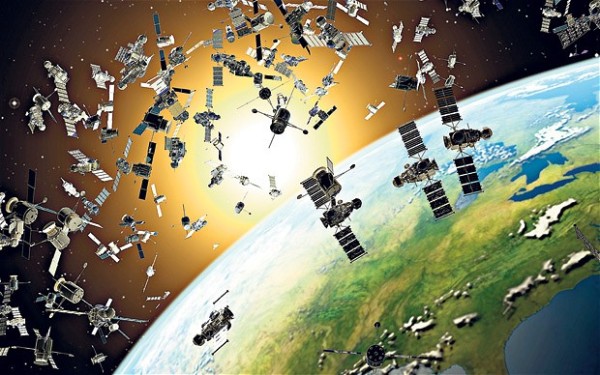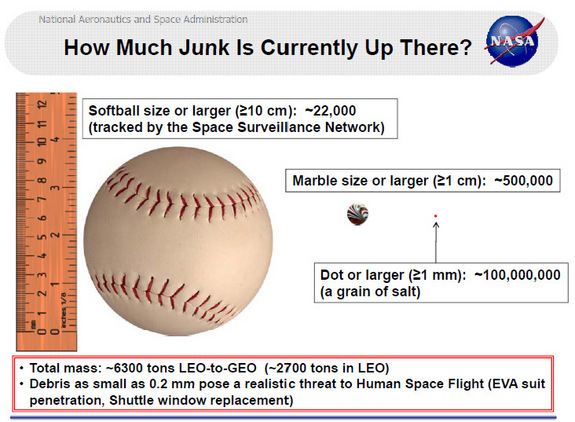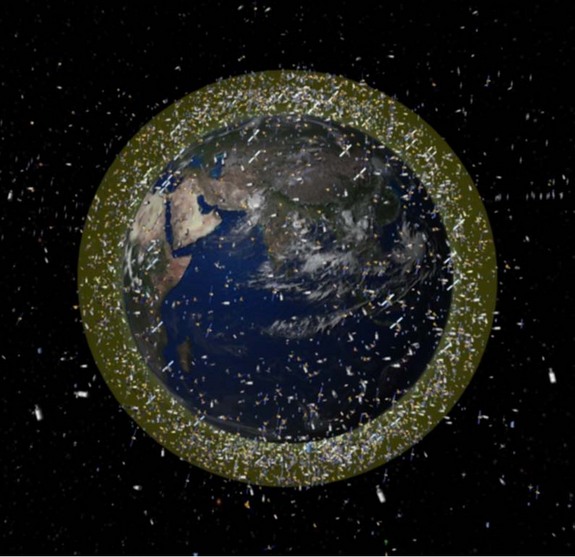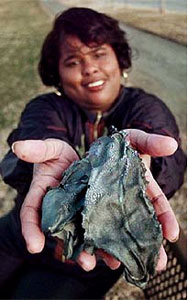A conceptual drawing of space junk, depicting defunct satellites, failed missions and shrapnel orbiting Earth.Close Call: Space Junk Threatens Int’l Space Station
Now the subject of a fascinating 3D Imax film, space junk is in the news again. SPACE.com's managing editor Tariq Malik reports that a leftover piece of an old Russian satellite forced six astronauts on the International Space Station to take shelter in a pair of lifeboat-like space capsules on March 24, but, to the crew's relief, zipped harmlessly by the outpost.
The piece of space junk was spotted too late to move the orbiting laboratory out of the way and flew as close as 6.8 miles (11 kilometers) when it zoomed by at about 2:38 a.m. EDT, according to NASA officials.
While the chances of collision were remote, the potential danger of a hit was enough for Mission Control to order the station crew, which includes three Russians, two Americans and a Dutch astronaut, to seek shelter in two docked Soyuz space capsules just in case a quick escape to Earth is required.
"I don't see anything, which is good news," one of the station astronauts said in Russian, which was translated in a NASA broadcast.
It was the third time in 12 years that station astronauts took shelter from a close space debris pass.
NASA and its partners typically order an avoidance maneuver when a piece of space junk is expected to pass close by the space station and there are several days of advance notice. But this latest space debris threat was initially spotted on Friday morning, too late to plan a major maneuver, NASA officials said.
"We're not too concerned about it, but it's too late to do a [debris avoidance maneuver]," station flight director Jerry Jason radioed station commander Daniel Burbank, of NASA, and his crew late Friday.
Space Debris Levels: This computer illustration depicts the density of space junk around Earth in low-Earth orbit. (Credit: ESA)According to NASA updates, the space debris is a remnant of the Russian Cosmos 2251 communications satellite. In 2009, the defunct spacecraft crashed into the U.S. satellite Iridium 33 in a massive space collision that created a huge cloud of more debris. The crash created 2,000 pieces of orbital debris.
While the size of the space debris was difficult to pin down, it was "relatively small," NASA spokesman Rob Navias said during NASA TV commentary of the space trash flyby.
Lottie Williams with space debris: In 1997, Lottie Williams of Tulsa, Oklahoma, reported that she was struck on the shoulder by falling debris while walking. It was later confirmed to be part of the fuel tank of a Delta II rocket. Additional debris from the Delta second stage re-entry were recovered several hundred miles away in Texas. (Photo Credit: Center for Orbital and Reentry Debris Studies [Tulsa World')Space junk is a growing threat for astronauts on the space station, as well as other satellites orbiting Earth. According to recent estimates, there is about 6,000 tons of space debris in orbit today. NASA and the U.S. military's Space Surveillance Network regularly track about 20,000 pieces of the debris in order to help other active satellites avoid collisions with the orbital trash.
See our our January 2012 issue for a report on Space Junk 3D, a new IMAX 3D film spotlighting the danger from human-made orbital rubbish in an effort to raise awareness regarding a thus-far unchecked interstellar threat, plus an interview with the film's director, Melissa Butts.
Founder/Publisher/Editor: David McGee
Contributing Editors: Billy Altman, Laura Fissinger, Christopher Hill, Derk Richardson
Logo Design: John Mendelsohn (www.johnmendelsohn.com)
Website Design: Kieran McGee (www.kieranmcgee.com)
Staff Photographers: Audrey Harrod (Louisville, KY; www.flickr.com/audreyharrod), Alicia Zappier (New York)
E-mail: thebluegrassspecial@gmail.com
Mailing Address: David McGee, 201 W. 85 St.—5B, New York, NY 10024






